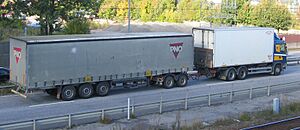Trailer (vehicle) facts for kids
A trailer vehicle is like a special wagon that doesn't have its own engine. It needs to be pulled by another vehicle, usually a truck or a car, to move around. Think of it as a helpful friend that carries extra stuff!
Trailers are super useful for moving things that are too big or too many for the main vehicle. This could be anything from boxes and furniture to animals like horses, or even boats that need to be moved on land.
Contents
What is a Trailer Vehicle?
A trailer is a vehicle designed to be pulled. It doesn't have its own power source, like an engine. Instead, it connects to a powered vehicle, such as a truck, car, or even another trailer. The vehicle in front provides all the power to make the trailer move.
Trailers are often used to carry cargo. This cargo can be non-living items, like supplies for a construction site or goods for a store. They can also transport living things, such as horses or other large animals that wouldn't fit inside a regular car. Some boats are also designed to be moved on special boat trailers when they are out of the water.
How Do Trailers Connect?
Trailers connect to the pulling vehicle using a special part called a hitch or a coupling. This connection makes sure the trailer stays securely attached while moving. There are different types of hitches depending on the size and weight of the trailer.
Common Hitch Types
- Ball Hitch: This is a common type where a metal ball on the pulling vehicle fits into a socket on the trailer. It's often used for smaller trailers like utility trailers or travel trailers.
- Gooseneck Hitch: This type of hitch is found in the bed of a pickup truck. It uses a strong connection that extends over the truck's rear axle. Gooseneck hitches are very strong and are used for larger trailers, like horse trailers or some heavy cargo trailers.
- Fifth-Wheel Hitch: Similar to a gooseneck, a fifth-wheel hitch is also mounted in the bed of a pickup truck or on a semi-truck. It looks like a large, flat plate with a locking mechanism. This type of hitch is very strong and stable, often used for very large travel trailers or semi-trailers.
Different Kinds of Trailers
There are many different types of trailers, each designed for a specific job.
Utility Trailers
These are open trailers, often with low sides, used for hauling general items. You might see them carrying lawnmowers, ATVs, or moving boxes. They are very versatile for everyday tasks.
Cargo Trailers
Cargo trailers are enclosed, like a box on wheels. They protect items from weather and theft. People use them to move furniture, tools, or even for businesses that need a mobile workshop.
Travel Trailers
Also known as campers or RVs (Recreational Vehicles), these trailers are designed for people to live in while traveling. They can have beds, kitchens, and bathrooms, making them like a home on wheels for adventures.
Boat Trailers
These trailers are specially shaped to carry boats. They have supports that fit the boat's hull, allowing it to be easily launched into and pulled out of the water.
Horse Trailers
Horse trailers are built to safely transport horses. They have special compartments and features to keep the animals comfortable and secure during travel.
Flatbed Trailers
Flatbed trailers are simply a flat platform without sides or a roof. They are used for carrying very large or unusually shaped items that wouldn't fit in an enclosed trailer, like machinery or building materials.
Semi-Trailers
A semi-trailer is a large trailer that does not have front wheels. Instead, its front part rests on a special connection called a "fifth wheel" on a semi-truck (also called a tractor unit). These are the long trailers you see on highways carrying goods across the country.
Full Trailers
Unlike semi-trailers, full trailers have wheels at both the front and the back. They are pulled by a drawbar and can carry heavy loads. Sometimes, a full trailer might even be pulled by another semi-trailer, using a special connector called a dolly.
Images for kids
See also
 In Spanish: Remolque para niños
In Spanish: Remolque para niños














